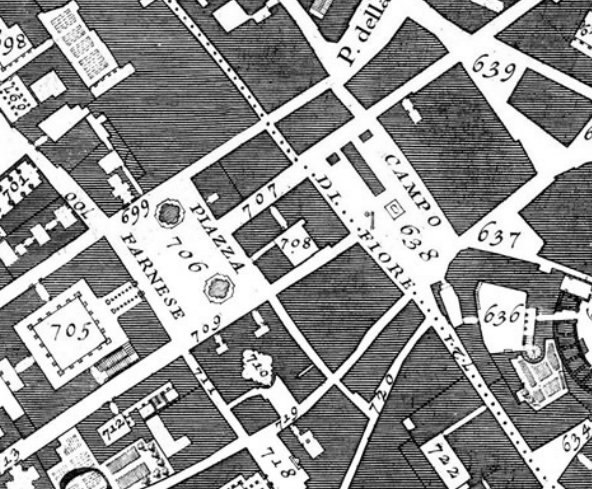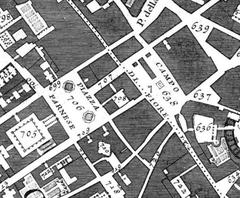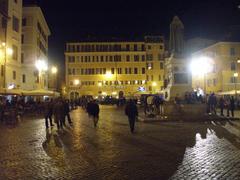
Campo de’ Fiori Rome: Visiting Hours, Tickets & Historical Sites Guide
Date: 14/06/2025
Introduction: The Enduring Allure of Campo de’ Fiori
Nestled in Rome’s historic heart, Campo de’ Fiori—literally “Field of Flowers”—encapsulates the Eternal City’s rich layers of history, culinary tradition, and vibrant social life. From medieval meadow to bustling urban piazza, this square has evolved through centuries of transformation, becoming a symbol of both Rome’s dynamic daily rhythms and its enduring struggles for free thought (rome.us; italy-sights.info). Today, Campo de’ Fiori is renowned for its colorful daily market, lively cafés and bars, and proximity to Rome’s most iconic landmarks. Whether you’re a first-time visitor or a seasoned traveler, the piazza offers a unique lens into Roman culture, tradition, and contemporary vibrancy.
Table of Contents
- Origins and Historical Evolution
- Marketplace Traditions
- A Stage for History: Executions and Intellectual Dissent
- Urban Transformation and Architecture
- Visiting Campo de’ Fiori: Hours, Tickets & Accessibility
- Modern Life: Nightlife and Culture
- Nearby Attractions
- Frequently Asked Questions (FAQ)
- Practical Tips for Visitors
- Visuals and Media Suggestions
- References & Further Reading
- Summary & Recommendations
Origins and Historical Evolution
Campo de’ Fiori’s name reflects its earliest incarnation as a wildflower-filled meadow situated just outside medieval Rome’s dense urban core (rome.us; italy-sights.info). For centuries, the area remained undeveloped, subject to Tiber River flooding. The transformation began in 1456 under Pope Callixtus III, who initiated the paving and urbanization of the Parione district. This strategic redevelopment fostered the construction of surrounding palazzi and businesses, setting the stage for Campo de’ Fiori’s emergence as a bustling urban square.
By the late 15th century, the square had become a natural crossroads for merchants, travelers, and locals—its open space and central location fueling rapid growth as a commercial and social hub.
Marketplace Traditions
Since the Renaissance, Campo de’ Fiori has been synonymous with commerce and daily Roman life. The open-air market, formally established in 1869 after relocating from Piazza Navona, remains the square’s beating heart (italy-sights.info; Bags and Fruits; VisitRome). Vendors call out their wares amid an array of fresh produce, flowers, local cheeses, meats, spices, and artisanal goods. The tradition of the “vignarole” (women from the countryside bringing fresh vegetables) continues in spirit as the market draws both locals and visitors in search of authentic flavors and lively ambiance.
The market’s offerings change with the seasons: artichokes and wild greens in spring, figs and tomatoes in summer, citrus and mushrooms in autumn. Alongside produce, you’ll find stalls selling olive oils, balsamic vinegars, truffle products, pasta, and household goods, as well as souvenirs and kitchenware (The Roman Guy).
A Stage for History: Executions and Intellectual Dissent
Campo de’ Fiori’s story is not solely one of commerce. In the Middle Ages and Renaissance, it was the site of public executions and civic spectacles. The most infamous event occurred in 1600, when philosopher Giordano Bruno was burned at the stake for heresy—a moment that cemented the square’s association with free thought and dissent (rome.net; wantedinrome.com). Bruno’s bronze statue, erected in 1889, stands at the center of the piazza as a powerful symbol of intellectual freedom and resistance to oppression.
The square’s history as a gathering place for both protest and celebration reinforces its central role in Rome’s civic life. From market days to political rallies and processions, Campo de’ Fiori continues to serve as a vibrant stage for public engagement (pps.org).
Urban Transformation and Architecture
Unlike many Roman piazzas, Campo de’ Fiori lacks a central church or palace, underscoring its origins as a civic and commercial space (rome.us). Its irregular shape and surrounding Renaissance and Baroque buildings reflect organic development rather than grand papal planning. The square’s architecture is modest but functional, housing a mix of shops, restaurants, and residences. The historic La Terrina Fountain and the intricate network of neighboring streets evoke the area’s artisanal and mercantile roots (My Adventures Across the World).
Visiting Campo de’ Fiori: Hours, Tickets & Accessibility
Visiting Hours
- Square: Open 24/7, year-round.
- Market: Monday–Saturday, 7:00 AM – 2:00 PM. Closed Sundays (Bags and Fruits; RomeWise).
Tickets and Entry Fees
- No entrance fee required for the square or market.
Accessibility
- Flat, pedestrianized with some uneven cobblestones. Most visitors, including those with limited mobility, will find it accessible, though assistance may be needed in certain areas (The Roman Guy).
Getting There
- Public Transport: Bus lines 62, 64, 116, tram 8; walkable from Piazza Navona and Pantheon; closest metro is Spagna (Line A).
- Taxi, rideshare, and bike rentals are also available nearby.
Modern Life: Nightlife and Culture
As day transitions to evening, Campo de’ Fiori morphs into one of Rome’s liveliest social hubs, beloved for its open-air bars, cafés, and vibrant nightlife (nightflow.com; romeing.it). Aperitivo culture flourishes as locals and tourists gather for drinks and small bites. Street performers and musicians energize the square, especially on weekends.
Notable nightlife venues include:
- Argot: Underground cocktail bar with a speakeasy vibe (romeing.it).
- Chapter Roma: Stylish hotel bar blending Roman tradition with international flair (romeing.it).
- Clorofilla Cucina e Distillati: Botanical-themed cocktails and live music (romeing.it).
For quieter evenings, opt for a stroll to nearby Piazza Navona or the Jewish Ghetto, both offering distinct atmospheres and additional dining options (mamalovesrome.com).
Nearby Attractions
- Piazza Navona: Baroque fountains, lively street artists.
- Pantheon: Ancient Roman temple, beautifully illuminated at night.
- Palazzo Farnese: Majestic Renaissance palace (now the French Embassy).
- Jewish Ghetto: Historic quarter with unique culinary and cultural offerings.
All are within easy walking distance, making Campo de’ Fiori an ideal starting point for exploring central Rome.
Frequently Asked Questions (FAQ)
Q: What are Campo de’ Fiori’s visiting hours?
A: The square is open 24/7. The market runs Monday–Saturday, 7:00 AM–2:00 PM.
Q: Is there an entrance fee or ticket required?
A: No, both the square and market are free to enter.
Q: Is Campo de’ Fiori accessible for people with disabilities?
A: Yes, though some cobblestone areas may be uneven; assistance may be helpful.
Q: Are guided tours available?
A: Yes, many walking and food tours of Rome include Campo de’ Fiori as a highlight (My Adventures Across the World).
Q: What’s the best time to visit?
A: Early morning for the market; evenings for nightlife.
Q: Is Campo de’ Fiori safe?
A: Generally yes, but remain vigilant against pickpockets, especially during busy hours.
Practical Tips for Visitors
- Footwear: Wear comfortable shoes for uneven surfaces.
- Cash: Bring cash, as some market vendors do not accept cards.
- Reusable Bag: Handy for market purchases.
- Dress Code: Casual during the day; smart-casual for certain cocktail bars.
- Food & Drink: Sample pizza bianca, supplì, and local wine.
- Guided Experiences: Enhance your visit with a food or history tour.
- Early Visits: Beat the crowds and enjoy the freshest produce.
Visuals and Media Suggestions
- Campo de’ Fiori market by day: Colorful stalls and shoppers (alt: “Campo de’ Fiori market bustling with vendors and visitors in Rome”).
- Giordano Bruno statue: Central monument (alt: “Statue of Giordano Bruno in Campo de’ Fiori, Rome”).
- Nightlife scene: Outdoor dining and lively crowds (alt: “Campo de’ Fiori nightlife with open-air restaurants and social gatherings”).
- Nearby landmarks: Piazza Navona fountains, Pantheon at sunset.
References & Further Reading
- Campo de’ Fiori on Italy Sights
- Rome Neighborhoods: Parione (rome.us)
- Campo de’ Fiori (rome.net)
- Campo de’ Fiori Market Guide (Bags and Fruits)
- Campo de’ Fiori Market Heartbeat of Rome Food Culture (VisitRome)
- Rome Nightlife Guide (Nightflow)
- Bars in Campo de’ Fiori (Romeing.it)
- Campo de’ Fiori Market and Square (JamTravelTips)
- Campo de’ Fiori Historical Sites (rome.us)
- Official Rome Tourism Website (Turismo Roma)
- Wanted in Rome: Campo de’ Fiori
For guided audio tours, updates, and personalized recommendations, download the Audiala app.
Summary & Recommendations
Campo de’ Fiori is a microcosm of Rome’s enduring vitality—where history, culture, and daily life converge. Its storied market, powerful monuments, and lively nightlife invite visitors to immerse themselves in both the past and present of the Eternal City (italy-sights.info; The Roman Guy; nightflow.com; rome.net). Whether you come for the freshest produce, a taste of Roman cuisine, or a night on the town, the square promises an unforgettable experience.
Plan ahead: Arrive early for the market, linger into the evening for nightlife, and explore nearby attractions. For the latest tips and curated guides, rely on trusted resources like the Audiala app and Turismo Roma.
Embrace the spirit of Campo de’ Fiori—Rome’s living testament to history, community, and urban charm.



















































































































































































































































